Russian salad or Salad Olivier (ruska salata, insalata Russa) is a holiday staple in Balkan homes. Delicious, rich, and filling, this salad is at once an appetizer, side dish, and the main course. Can another salad say the same? We didn't think so!
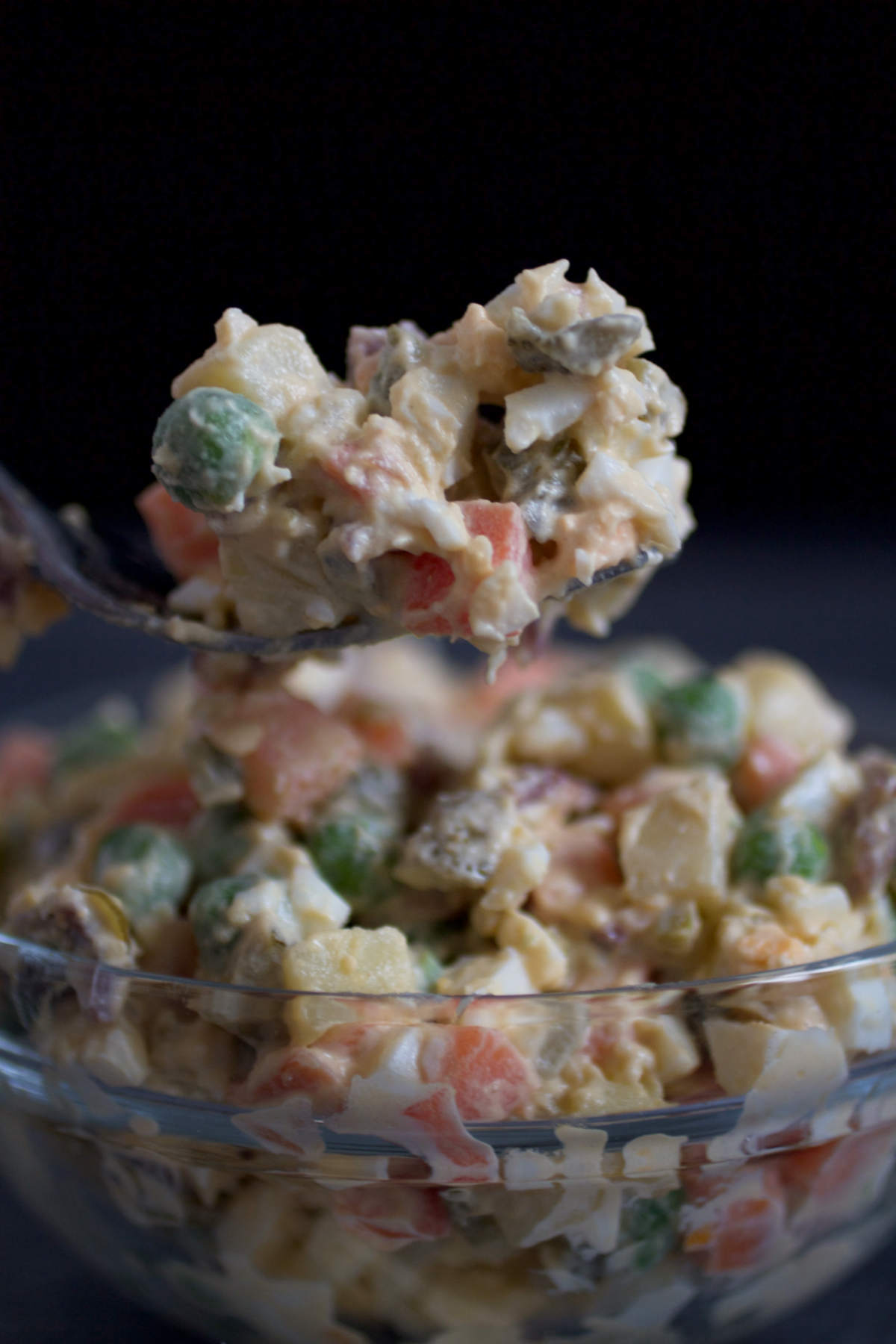
Jump to:
- What Is It
- Russian Salad Ingredients
- Ingredient Notes for Salad Olivier
- Russian Salad Dressing
- Lightning-fast Instructions for Salad Olivier
- Variations
- Expert Tips
- Serving, Storing, Freezing
- Recipe FAQs
- More Salads You'll Be Crazy About
- Can You Do Me a Solid?
- Russian Salad or Salad Olivier
- Let's Combine This into a Meal!
What Is It
Russian salad, or Salad Olivier, is probably the best salad to come out of Russia. (We'll be using the terms interchangeably!) It's a hearty, filling dish made with veggies, meat, and a dressing. Very much a New Year's Eve kind of thing!
It's delicious. It lasts a long time... and it's a salad with a story!
Invented by the Belgian chef Lucien Oliver in 19th century Moscow (who was also the owner of the then-famous restaurant Hermitage), it was hugely popular.
Original salad Olivier involved interesting ingredients like caviar, veal tongue, and smoked duck. However, the exact recipe isn't known even today. Olivier was a paranoid guy. He kept the ingredients and cooking directions a secret.
With good reason!
At some point, his sous-chef Ivanov figured out most of the recipe. Ivanov then: 1. left Hermitage, 2. opened up the restaurant Moskva, and 3. served the salad under a new name. To add insult to injury, he also sold his adapted version to the newspapers!
As time passed, Olivier salad spread through the Soviet and post-Soviet countries until it found its place in kitchens all over Europe, including the Balkans.
Of course, much changed during the decades of this transition. The salad took on a new name (Russian salad or ruska salata), dropped a few ingredients, and became what we have today.
Russian Salad Ingredients
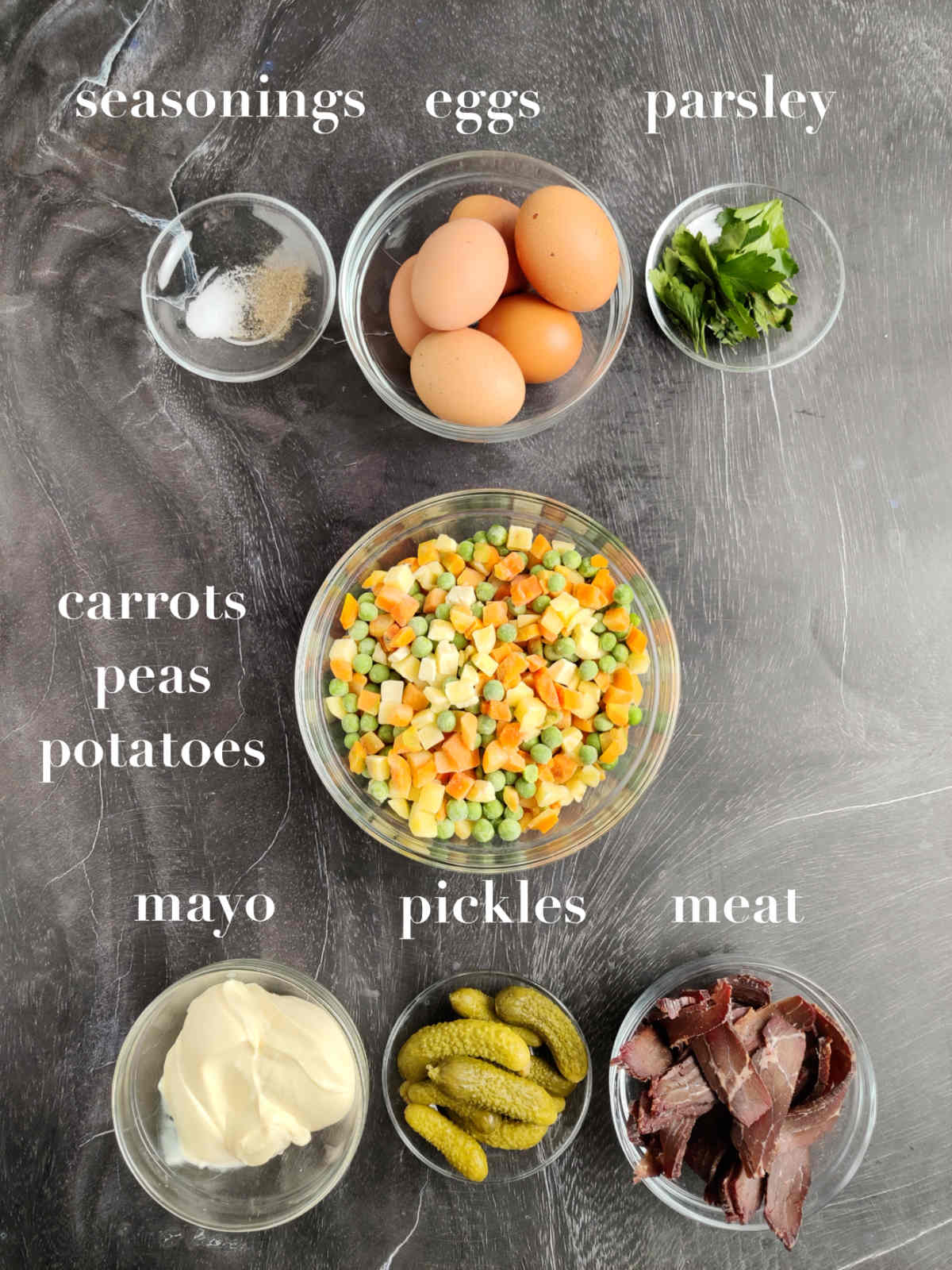
Ingredient Notes for Salad Olivier
Eggs: More is more here, so 4 minimum. Eggs balance out and soften heavier ingredients. Sub with duck, goose, or quail eggs, but be aware that each has a different taste.
Vegetables: Peas, carrots, and potatoes, plus pickles are all you need. If using frozen, cook for a shorter period of time. Canned works too.
To make it easier on yourself, get the same type of veggies (either frozen, fresh, or canned). Try to avoid canned veggies though, as they're too mushy.
Meat: Smoked beef or cured smoked or baked ham are the best choices. Sub with chicken or turkey breast, prosciutto, canned, fried, or baked fish, and bologna or salami. (Bologna or salami should be your last option!)
Herbs and Seasonings: Less is more. Don't overwhelm this already rich salad. Salt and pepper to taste, as well as minced parsley garnish, are perfect. (Some like to add dill, which overpowers the taste. Be careful!)
Dressing: Look below!
Russian Salad Dressing
Mayonnaise is the foundational Olivier salad dressing. Yup, good ol' mayo is all you need!
- The best kind is homemade. However, if you don't have the time, mayo from your grocery store will do just fine. Get plain mayo from a brand that makes it on a milder side, otherwise it will hijack the salad taste.
- Some like to spice the mayo up with lemon and mustard, but this is optional.
If you're no fan of mayo here are ideas for substitutions for the Russian salad dressing:
- Half mayo half sour cream. Mix the two, then mix them into the salad.
- Sour cream. A pinch of olive oil and lemon is optional.
- Sour cream and soy sauce.
- Greek or plain yogurt. Look for a consistency similar to mayo.
- Kefir with yolks from boiled eggs.
The best way to add the dressing is to add a little at a time until you are happy with the consistency. Check and add more before serving if necessary.
Lightning-fast Instructions for Salad Olivier
(Our lightning-fast instructions are here to give you an idea of how to make this dish. For more detailed information look at the recipe card below!)

1. Layer ingredients in a large bowl starting with veggies, then eggs, pickles and meat.

2. Add mayo in batches, and continue stirring until integrated. Cover with saran wrap, and leave in fridge 3-4 hours (preferably overnight).
Variations
Here are the dish variations:
- French Salad: Vegetarian version of Olivier salad (no meat or fish).
- Muslim and Jewish friendly: No pork.
- Orthodox fast friendly: Remove eggs and meat (fish is ok) and make sure dressing (mayo) is homemade and fast approved.
Expert Tips
Here are a few tips that make my Olivier salad the best in the family!
Ingredient size: The smaller the better. Ingredients should match in size. If using frozen veggies it's easiest to use them as a guide as they're usually diced. Otherwise, think half the size of a sugar cube, or smaller.
Mixing: Mix ingredients in batches and thoroughly. First the veggies, then add eggs, pickles, and meat. When all are integrated, add the dressing.
Make ahead: Olivier salad tastes best on day 2 after the flavors have settled together in the fridge.
Add your signature: This is one of those salads you should make your own. Add and subtract ingredients until you think it tastes perfect. For me, I add less mayo and more eggs. For you, it may be less meat and more pickles, etc.
So, less mayo is more! And also, more eggs is more!
Serving, Storing, Freezing
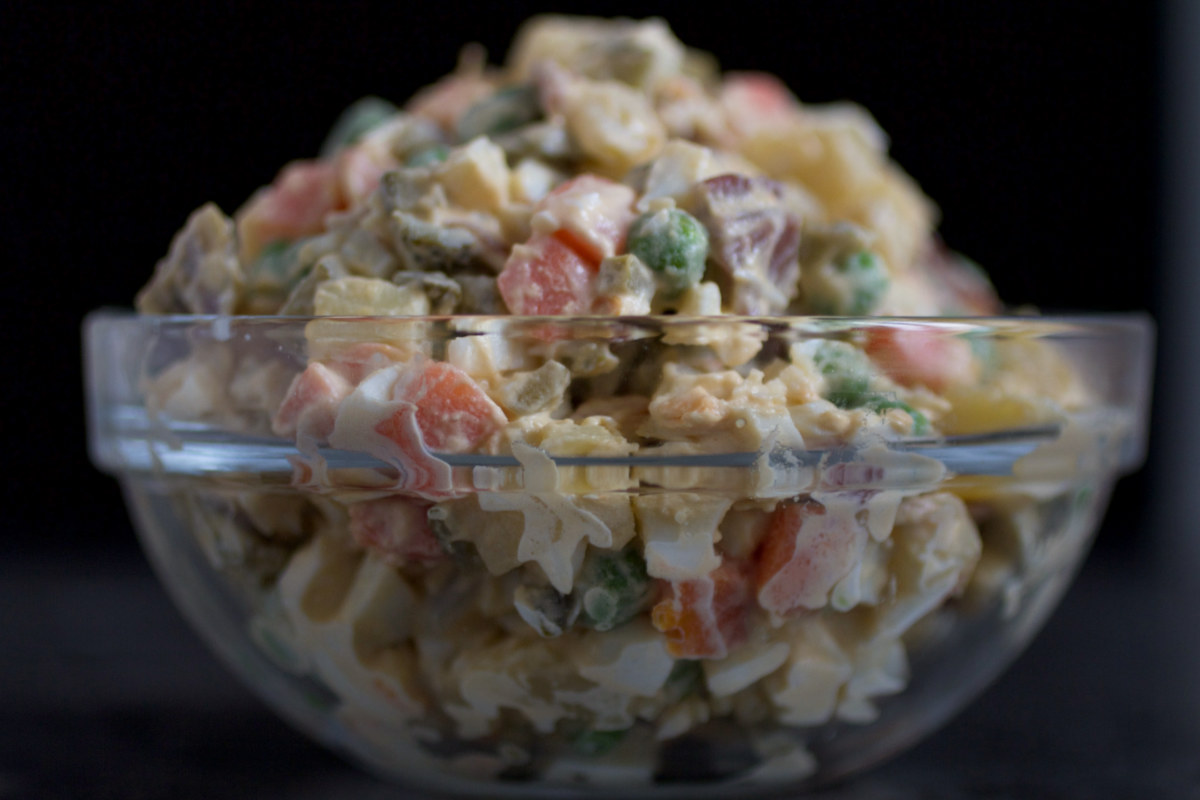
Serving: Serve as a side or a main dish for breakfast, lunch, or dinner. Take it to a potluck, picnic, or barbeque. It goes splendidly with bread, toast, buns, and crackers. Best if prepared at least the night before.
Storing: Store in the fridge for up to 7 days.
Freezing: Don't even think about it!
Recipe FAQs
Russian salad was originally called Oliver salad based on the Moscow-based Belgian chef who invented it. During the 20th century, the dish spread throughout Europe and adopted the name Russian salad.
Russian salad calories greatly depend on its dressing. For example, it'll be more caloric if you use mayo versus if you were to use sour cream.
Too many to count!
Russia, former Soviet countries, Ex-Yugoslavia states, the remainder of the Balkan countries, and finally, Mediterranean countries. Also, other countries with the diaspora populations of the abovementioned countries. (We heard it reached Argentina!?!)
So, people all over the world eat Russian salad. You should too!
More Salads You'll Be Crazy About
- The prettiest of them all: Beat & Carrot Salad
- So tasty everyone fights over it: Shopska Salad
- Garlicky to starve off energy vampires: Red Pepper & Garlic
- How about some cabbage baby: Fermented Cabbage
- You can't say no to tuna and egg: Tuna & Egg
Can You Do Me a Solid?
If you make Russian Salad and like it, please leave a ⭐️⭐️⭐️⭐️⭐️ (5-star) rating. This will help others find the recipe more easily!
You can also leave a comment, I read EVERY one! Otherwise, if IG is more your thing, consider tagging us @balkanlunchbox.
Prijatno and bon appetit!
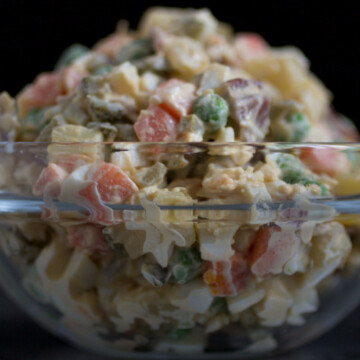
Russian Salad or Salad Olivier
Ingredients
- 10 ounces carrots medium, peeled, diced, cooked until fork tender
- 10 ounces potatoes peeled, diced small, cooked until fork tender
- 10 ounces sweet peas cooked until fork tender*
- 5-6 eggs hard boiled, peeled, diced
- 7 ounces ham or dried/smoked beef, cooked skinless chicken or fish, diced
- 3 ounces pickles about 5-7 medium, diced small
- 10-12 tablespoons mayonnaise plain, milder brand, use 10 tablespoon first and 2 more before serving after fridge
- Salt and pepper to taste
- 2-3 tablespoons fresh parsley minced
Instructions
- In a large bowl start layering ingredients. Start with cooked vegetables, add eggs, pickles, and meat. As you're adding them mix them until they're thoroughly integrated.
- Add mayo in batches (about 10 tablespoons), and continue stirring until integrated. Cover bowl with saran wrap and leave in the fridge for at least 3-4 hours, preferably overnight. If necessary, mix in two more tablespoons of mayo before serving.

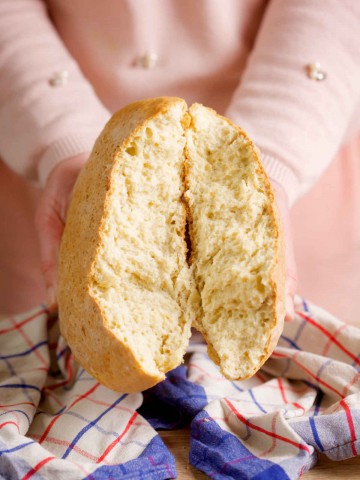
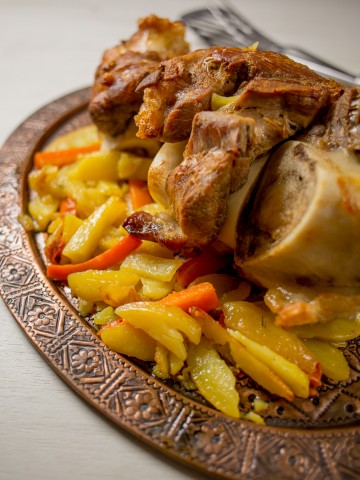
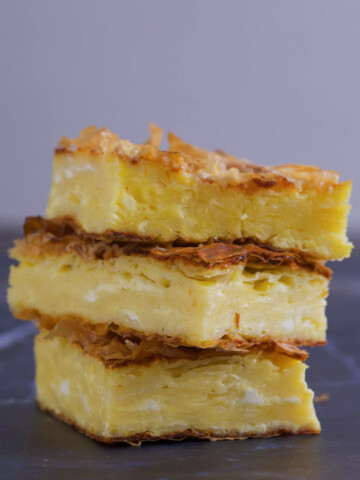
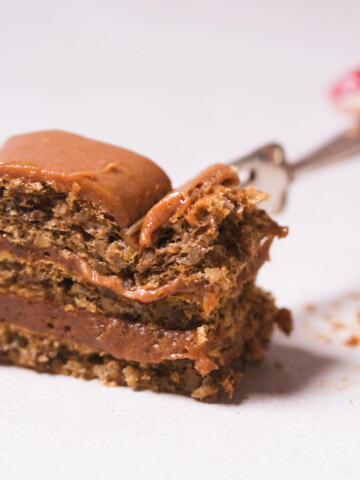

Katya @ Little Broken says
Ahh...yes! The popular Olivie salad. It's a holiday must and tradition in our household. Love the pickles w/ham decor 🙂
aida says
Welcome Katya! Yes, indeed a holiday must... although I try to make it more often too, it such a comfort food. I will try your perogis soon.
Matea says
Francuska salata is a family favorite for us! Thanks for sharing that bit of its history; I'm pretty sure I would have done the same as Ivanov--this salad is delicious! 🙂
aida says
Ahahaha! Yes, if it wasn't for Ivanov we'd have no "cold" salad for every single holiday.
Mary | Cooking Reporter says
I love love Russian salad. It brings so many memories. When we were little, my mother used to make a big bowl of it as a New Years special treat. Thanks for sharing!
aida says
My pleasure Mary. Thank you for visiting the blog!
Alla says
Familiar recipe! I remember you made this for your book club last year and it was delicious! I've tried making the recipe myself but it's never turned out well. Next time I'll try your version!
aida says
You're an expert cook and I'm sure it will turn out great. I still yearn for those stuffed mushrooms you made for book club back while you were in ARL.
Gary says
What type of pickles - dill, bread and butter, sweet or Kosher?
Aida says
I like dill. Others are fine too, except the sweet.
Vicky says
This just sounds delicious. I have printed the recipe. I will have to try it.
Aida says
Let us know how you like it!
Dawn @ The Kitchen and a Latte says
I am in the USA so we never tried this before but it sounds amazing 🙂 Your salad makes our traditional potato salad seem pretty boring haha! Definitely going to try this, I never thought to put pickles in salad (I put cucumbers in my pasta salads so why not pickles, right?) And I planted a bunch of pickling cucumber plants this year so maybe I can even make this with homemade pickles.
Aida says
Hi Dawn!
Yes, pickles are the best, especially homemade! I think you'd like this salad!